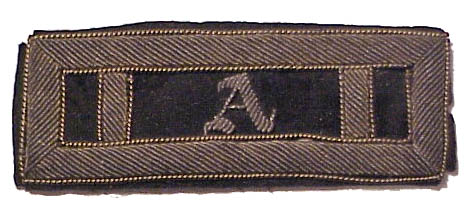Regimental Adjutant's Shoulder Strap

Regimental Adjutant and First Lieutenant's Shoulder Strap

This is an example of a non-regulation, miniature Civil War shoulder strap (one and one-eighth by 3 inches in size) for a regimental adjutant and first lieutenant. The vast majority of officers serving as adjutants wore a plain first lieutenant's shoulder strap without the script letter "A" as seen on this example. In addition to this artifact there are also photographs showing adjutants wearing similar shoulder straps that have the letter "A" but it is fair to say these are very rare. This particular strap has three-eighth inch borders made entirely of dead bullion. The gold first lieutenant's bars meet the border. The bottom is finished off. The script letter "A" is done in silver bullion.
Officers bought their uniforms and insignia privately and were not issued them out of government stores in the same manner as enlisted men. As a result they were able to add individual features, such as letters to the field of shoulder straps should they wish to do so. The addition of letters for officers of staff departments is very well known from artifacts, photographs and period illustrations. Surgeons, for example, often wore straps with the letters "MS" for medical staff. However, this practice was not sanctioned by regulations. The logic behind doing it was that the uniforms of all categories of staff officers looked the same and there was some value in distinguishing a surgeon from a quartermaster.
The colonel of a regiment typically would choose one of the lieutenants in the regiment to serve as the regimental adjutant. This man served at the colonel's will and might be returned to his company if the colonel wished to replace him. The principle duty of the adjutant was to assist the colonel with administration of the regiment and with paper work. They also functioned as an aide and on the battlefield might be asked to transmit orders to one of the company commanders or take reports or requests to superior officers. These kinds of activities are not without risk and more than a few adjutants became causalities. The adjutant also figured very prominently in the ceremony involving a regiments dress parade. He was the one, not the unit commander, who spoke the commands to the regiment during the regiment's parade, review and inspection. He also was in charge of mounting guards. Adjutants were part of their regiment and not considered a member of the Army's Adjutant-General's Department. However, their duties would include sending reports to the Adjutant-General's office. It was not uncommon for an adjutant to be promoted into the captaincy of one of the regiment's companies and his duties then fall on another lieutenant within the regiment.